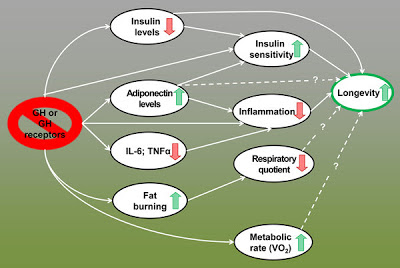

| Visitors Now: | |
| Total Visits: | |
| Total Stories: |

| Story Views | |
| Now: | |
| Last Hour: | |
| Last 24 Hours: | |
| Total: | |
Outline of the biology in mice that live up to 60% longer
From
Mice lacking Growth Hormone (GH) or GH receptors show numerous symptoms of delayed aging, are partially protected from age-related diseases, and outlive their normal siblings by 30–65% depending on genetic background, sex, and diet composition. Importantly, many of the metabolic features of long-lived mutant mice described in this article have been associated with extended human longevity. Comparisons between centenarians and elderly individuals from the same population and between the offspring of exceptionally long-lived people and their partners indicate that reduced insulin, improved insulin sensitivity, increased adiponectin, and reduced pro-inflammatory markers consistently correlate with improved life expectancy.
Genetic suppression of insulin/insulin-like growth factor signaling (IIS) can extend longevity in worms, insects, and mammals. In laboratory mice, mutations with the greatest, most consistent, and best documented positive impact on lifespan are those that disrupt growth hormone (GH) release or actions. These mutations lead to major alterations in IIS but also have a variety of effects that are not directly related to the actions of insulin or insulin-like growth factor I. Long-lived GH-resistant GHR-KO mice with targeted disruption of the GH receptor gene, as well as Ames dwarf (Prop1df) and Snell dwarf (Pit1dw) mice lacking GH (along with prolactin and TSH), are diminutive in size and have major alterations in body composition and metabolic parameters including increased subcutaneous adiposity, increased relative brain weight, small liver, hypoinsulinemia, mild hypoglycemia, increased adiponectin levels and insulin sensitivity, and reduced serum lipids. Body temperature is reduced in Ames, Snell, and female GHR-KO mice. Indirect calorimetry revealed that both Ames dwarf and GHR-KO mice utilize more oxygen per gram (g) of body weight than sex- and age-matched normal animals from the same strain. They also have reduced respiratory quotient, implying greater reliance on fats, as opposed to carbohydrates, as an energy source. Differences in oxygen consumption (VO2) were seen in animals fed or fasted during the measurements as well as in animals that had been exposed to 30% calorie restriction or every-other-day feeding. However, at the thermoneutral temperature of 30°C, VO2 did not differ between GHR-KO and normal mice. Thus, the increased metabolic rate of the GHR-KO mice, at a standard animal room temperature of 23°C, is apparently related to increased energy demands for thermoregulation in these diminutive animals. We suspect that increased oxidative metabolism combined with enhanced fatty acid oxidation contribute to the extended longevity of GHR-KO mice.
See more and subscribe to NextBigFuture at 2012-12-21 10:31:40 Source: http://nextbigfuture.com/2012/12/outline-of-biology-in-mice-that-live-up.html
Source:



